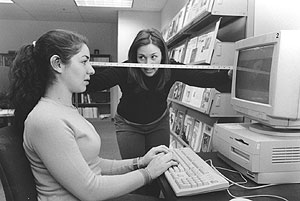 |
|
||
|
Vol. III No. 36 · Week of 23 June 2000 |
|||
B.U. Bridge is published by the Boston University Office of University Relations.
Ergonomist
spreads word on computer safety
By Hope Green
Three years ago, when her 13-year-old son and 11-year-old daughter complained of sore necks and achy arms, Karen Jacobs sensed that the problem was not just growing pains. The two had been using the family computer since they were little.
|
|
|
| Becca Jones (SAR’00) (right) checks Jennifer Elkin (SAR’00) for proper alignment. Both recently completed an Ergonomics for Therapists course taught by Karen Jacobs. Photo by Kalman Zabarsky | |
“I was observing them sitting there in very awkward postures,” says Jacobs (SAR’79), a clinical associate professor at Sargent College of Health and Rehabilitation Sciences and a certified ergonomist.
For working adults, the consequences of poor seating arrangements at the computer are well documented: disabling neck, back, and shoulder pain as well as repetitive-strain injuries to wrists and arms. Increasingly, however, these ailments are turning up in younger people, who sometimes spend hours gossiping in Internet chat rooms or typing their homework on a word processor.
In the Jacobs home, adjusting the furniture and the children’s computer habits appears to have averted serious problems, such as tendinitis or carpal tunnel syndrome. Yet the experience spurred Jacobs to get more involved professionally in the issues of computer use by adolescents. An ideal research site was close by: the public middle school her daughter attends in Andover, Mass. Besides volunteering her time to teach a Healthy Computing class, Jacobs began compiling data from the students.
In an initial survey of 82 sixth graders, 34 percent told Jacobs they had experienced tingling in their hands and a sore neck and shoulders. Jacobs could not rule out sports-related sprains or overstuffed backpacks as the culprits. She suspects, however, that many children are hurting because they contort themselves at the keyboard for hours at a time, forgetting to stop and stretch.
Jacobs plans to continue her research at the school in September as part of a three-year study, with help from SAR graduate students.
“Over the next two years,” she says, “we hope to determine whether our intervention strategies, such as teaching children proper body mechanics and monitoring their time on the computer, are effective in decreasing their musculoskeletal problems.”
Expert opinion
Jacobs, who also runs an antiviolence program for eighth graders at the middle school, is a national authority on workplace health issues, ergonomics included. This year she will complete a three-year term as president of the American Occupational Therapy Association.
|
|
|
| Karen Jacobs | |
At Sargent, Jacobs has taught ergonomics courses for about 15 years; her textbook Ergonomics for Therapists is used around the world. Recently her course on the subject has spun off side benefits for the BU community. As part of their field work, class participants watch employees go about their daily tasks, from tapping keypads to shelving books, and then offer tips on retrofitting a desk or correcting a slouch. Jacobs has arranged the site visits through a collaborative arrangement with the University’s Office of Environmental Health and Safety.
“I have the students write up a report that’s equivalent to the kind I might prepare,” she says. “It’s pretty hands-on, though I do guide them through it.”
Room service
But with computer injuries on the rise in younger people, Jacobs has expanded the class effort to BU’s heavily wired dormitories. Her students have developed an educational flier for their peers explaining how to rig a safe workstation, and hope to deliver the leaflets to BU dorm rooms in the fall.
While Jacobs is focusing her research on teenagers and young adults, she is concerned that poor postural habits begin in toddlerhood. She cites preschoolers sitting mesmerized at computer games for hours, craning toward the monitor as their legs dangle from oversized chairs.
“Parents are buying computers for the whole family, so two-year-olds are using the same equipment as adults,” Jacobs says. “Politicians should look at the idea of warning labels for computers, because there’s nothing out there to protect kids.”
Tips on setting up an ergonomically safe workstation can be found in “Computing & Kids” and, for adults, “Smart Sitting at the Computer,” part of a series of consumer fact sheets published by the American Occupational Therapy Association. They can also be found online.
For further information, contact Karen Jacobs at 353-7516.
![]()
23
June 2000
Boston University
Office of University Relations

